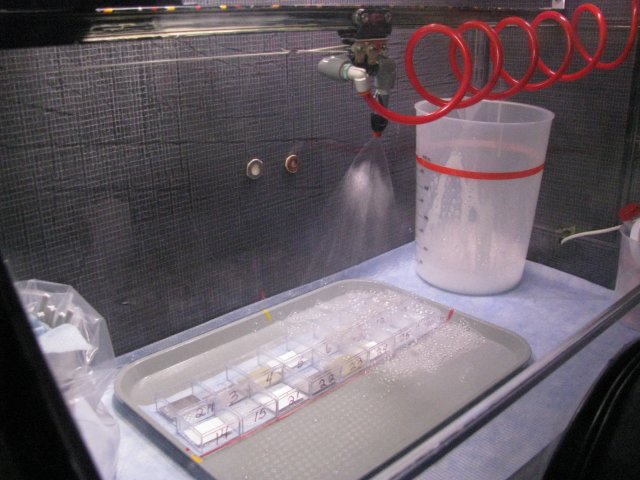Remediation of Fentanyl Contaminated Indoor Environments
Published November 29, 2022

In March 2016, the Drug and Enforcement Administration (DEA) issued a nationwide alert about fentanyl stating that overdoses were occurring at alarming rates and represent a significant threat to public health and safety. Recent research has shown the nation’s COVID19 pandemic has made the drug overdose epidemic worse. Since a small amount of fentanyl can be deadly, emergency responders, hazmat teams, and law enforcement are concerned about their potential exposure while responding to incidents at mixing houses, pill factories, or in makeshift laboratories that may be found in apartments, hotels, houses, garages, and storage facilities.
The use and production of various fentanyl-containing products can lead to extensive distribution of fentanyl within homes, vehicles, and clandestine drug laboratories. Drug-contaminated structures, homes or buildings pose a threat to human health, threaten community revitalization efforts, and pose challenges for federal, state, local, and Tribal governments and first responders. The lack of information on how to decontaminate structures and determine a safe level for re-occupancy has resulted in condemned properties, and EPA’s On-Scene Coordinators (OSCs) across the country are increasingly being asked to provide technical assistance to state and local entities for fentanyl incidents.
There is limited information available about methods to degrade fentanyl, or break it down so it is no longer harmful, or remediate fentanyl-contaminated areas, or the removal of the fentanyl, in real-world scenarios. To address this, EPA researchers investigated methods to degrade fentanyl safely in real-life remediation efforts by determining what effective and efficient mechanisms exist to clean an area contaminated with fentanyl and whether such technologies can also be used for decontamination of personal protective equipment (PPE) materials used during emergency responses.
EPA researchers tested the decontamination of building materials contaminated with fentanyl powder. They conducted tests that represented real-life cleanup efforts by using practical applied amounts of decontamination solutions and realistic exposure times onto common building materials and examined the efficacy of fentanyl degradation of various decontaminants and active ingredients. EPA researchers tested multiple off-the-shelf, easy-to-access products for their ability to degrade fentanyl on common materials, such as glass, plastics, laminate, and painted drywall. After spraying several decontaminants and leaving them on the surface for the one-hour contact time, EPA researchers determined that the peracetic acid or activated hydrogen peroxide, and acidified hypochlorite containing solution provided the most effective cleanup of fentanyl contaminated surfaces.
Additionally, EPA researchers studied methods for cleaning personal PPE worn by first responders, such as Tyvek suits, hazmat suits, firefighter turnout gear, and neoprene gloves. Decontamination of these materials needs to occur in a shorter timeframe, typically 1-5 minutes, as compared to the materials in a building. The results of this study demonstrated that special solutions containing peracetic acid are highly effective in degrading fentanyl on PPE in only a few minutes.
The results of this research will be used to scale up efforts to address a larger scale decontamination application and establishing effective operational procedures that will minimize additional hazards. Further research will also address materials that are more difficult to decontaminate, such as those that are more porous, fumigation methods for more complex contamination scenarios, and studies that assess harm of decontamination degradation products. This applies not only to fentanyl but also to more potent fentanyl analogs. EPA researchers will also be looking into how to answer “how clean is clean” for re-occupancy of fentanyl remediated areas. Answering these questions will provide the basis for additional guidance on the best way to remediate fentanyl and determine when a contaminated area is safe to reenter and use.
Research on fentanyl remediation is important for EPA, state and local governments, Tribes and first responders. Cheryl Newton, EPA Region 5 Deputy Regional Administrator said, “the number of incidents of fentanyl exposures to our partners at the federal, state, and local level continues to increase and the lack of information on effective decontamination agents is a national issue. EPA is often called upon to provide technical assistance in such incidents to not only protect first responders but on methods to decontaminate fentanyl contaminated areas and return them to safe use. These studies offer an unbiased evaluation of vendor and off the shelf products that can assist our responding partner agencies in the cleaning and decontamination of contaminated areas and personal protective equipment.”
EPA researchers are working closely with EPA responders to ensure that federal, state, Tribal, and local responders and hazmat teams are prepared with the best science to respond to incidents that involve synthetic opioids, including fentanyl.
Related Publications:
- Oudejans, L., D. See, C. Dodds, M. Corlew, AND M. Magnuson. Decontamination Options for Indoor Surfaces Contaminated with Realistic Fentanyl Preparations. JOURNAL OF ENVIRONMENTAL MANAGEMENT. Elsevier Science Ltd, New York, NY, 297:113327, (2021). https://doi.org/10.1016/j.jenvman.2021.113327.
- Oudejans, L. Remediation Options for Fentanyl Contaminated Indoor Environments. U.S. Environmental Protection Agency, Washington, DC, EPA/600/R-21/105, 2021.
- Oudejans, L. Research to Inform Decontamination Strategies, Methods, and Related Technical Challenges for Remediation of a Fentanyl-Contaminated Site. U.S. Environmental Protection Agency, Washington, DC, EPA/600/S-22/154, 2022.
